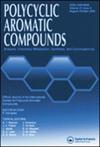Investigating the Anticancer Activity of Novel 1,2,4-Oxadiazole-Linked 1,2,3-Triazole Moieties via EGFR/pI3K/mTOR Cascade Down-Regulation
IF 2.6
3区 化学
Q2 CHEMISTRY, ORGANIC
引用次数: 0
Abstract
Malignant transformation, apoptosis prevention, drug resistance, and metastasis are all impacted by the EGFR/PI3K/Akt/mTOR pathway. Usually, mutations in lung and colon cancer alter the expression of this pathway. This led to the creation of a new hybrid of 3,5-diaryl-1,2,4-oxadiazole/1,2,3-triazoles. These hybrids were rationalized and synthesized using click reaction via the Copper catalyzed azide-alkyes cyclo-addition (CuAAC). The antiproliferative properties of the novel library were investigated against lung (A549), colon (Caco-2) cancer cell lines and human lung fibroblast (WI38). 5b, 5c, 8a, 8b, and 9c showed potent antiproliferative effects (IC50 9.18–12.8 µM) against lung (A549). While 8a and 9a showed substantial cytotoxic effects against the colon (Caco-2) cancer cell line, with IC50 of 13.0 and 12.0 µM, respectively. It is evident that, in comparison to normal cells, the selective cytotoxic of compound 5c (SI 9.4), 8a (SI 5.1), and 9c (SI 3.7) demonstrated a small selectivity for Caco-2 cells and a significantly higher selectivity for A549 lung cancer cells. Using a CqPCR assay, the powerful cytotoxic compounds 5c, 8a, and 9c were selected to investigate the mechanism of action of their anticancer activities. It is noteworthy that compounds 5c, 8a, and 9c were able to inhibit PI3K gene expression by 4.76–8.33 folds, downregulate mTOR by 4.26–4.81 folds, and downstream gene EGFR by 4.55–5.88 times. Additionally, they raised the amount of the p53 gene (a tumor suppressor gene), which bolstered their mode of action. Interestingly, docking experiments of 5c, 8a, and 9c demonstrated enhanced binding with the important amino acid residues in the EGFR active site (docking energy −7.13, −7.16, and −7.67 kcal/mol, respectively) in comparison to the reference drug gefitinib (−5.84 kcal/mol), which further corroborate their mode of action. The previously mentioned results indicated that the intriguing hits 5c, 8a, and 9c might be investigated as promising medications.
通过EGFR/pI3K/mTOR级联下调新型1,2,4-恶二唑- 1,2,3-三唑基团的抗癌活性研究
EGFR/PI3K/Akt/mTOR通路均影响恶性转化、细胞凋亡预防、耐药和转移。通常,肺癌和结肠癌的突变会改变这一途径的表达。这导致了一种新的3,5-二烷基-1,2,4-恶二唑/1,2,3-三唑的杂交产物的产生。通过铜催化叠氮烷环加成反应(CuAAC),对这些杂化物进行理顺合成。研究了该文库对肺癌(A549)、结肠癌(Caco-2)细胞系和人肺成纤维细胞(WI38)的抗增殖性能。5b、5c、8a、8b和9c对肺(A549)有较强的抗增殖作用(IC50为9.18 ~ 12.8µM)。而8a和9a对结肠(Caco-2)癌细胞表现出明显的细胞毒作用,IC50分别为13.0和12.0µM。很明显,与正常细胞相比,化合物5c (SI 9.4)、8a (SI 5.1)和9c (SI 3.7)的选择性细胞毒性对cco -2细胞的选择性较低,而对A549肺癌细胞的选择性明显较高。采用CqPCR方法,选择强效细胞毒化合物5c、8a和9c,研究其抗癌作用机制。值得注意的是,化合物5c、8a和9c能够抑制PI3K基因表达4.76 ~ 8.33倍,下调mTOR 4.26 ~ 4.81倍,下调下游基因EGFR 4.55 ~ 5.88倍。此外,他们提高了p53基因(一种肿瘤抑制基因)的数量,这加强了他们的作用模式。有趣的是,对接实验表明,与参比药物吉非替尼(- 5.84 kcal/mol)相比,5c、8a和9c与EGFR活性位点重要氨基酸残基的结合能力增强(对接能量分别为- 7.13、- 7.16和- 7.67 kcal/mol),进一步证实了它们的作用方式。前面提到的结果表明,有趣的撞击点5c, 8a和9c可能作为有前途的药物进行研究。
本文章由计算机程序翻译,如有差异,请以英文原文为准。
求助全文
约1分钟内获得全文
求助全文
来源期刊

Polycyclic Aromatic Compounds
化学-有机化学
CiteScore
3.70
自引率
20.80%
发文量
412
审稿时长
3 months
期刊介绍:
The purpose of Polycyclic Aromatic Compounds is to provide an international and interdisciplinary forum for all aspects of research related to polycyclic aromatic compounds (PAC). Topics range from fundamental research in chemistry (including synthetic and theoretical chemistry) and physics (including astrophysics), as well as thermodynamics, spectroscopy, analytical methods, and biology to applied studies in environmental science, biochemistry, toxicology, and industry. Polycyclic Aromatic Compounds has an outstanding Editorial Board and offers a rapid and efficient peer review process, as well as a flexible open access policy.
 求助内容:
求助内容: 应助结果提醒方式:
应助结果提醒方式:


